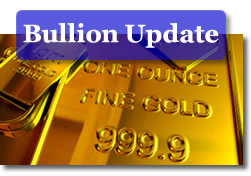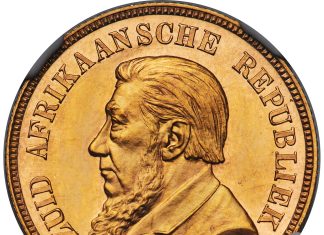 Good Morning,
Good Morning,
Circulating reports that the Fed’s putative QE2 may turn out to be somewhat dinghy-sized as opposed to an all-out behemoth to rival QE1, put a dent into market participants’ plans to lift gold well beyond the $1,300 mark for the moment.
The US central bank is said to be considering certain open-ended, but smaller-scale bond purchases as opposed to some kind of "massive" bond purchases that come with a finite end.
The Wall Street Journal reports that rather than launching a Nimitz-class carrier full of said bonds and using a "shock-and-awe approach" campaign to carry out monetary policy, the Fed may test more of a Zumwalt-class bond-hurling vessel with which to wipe out deflationary threat targets still lurking offshore.
The mere mention of such a possible tactical shift in Fed anti-deflation warfare helped spur a recovery in the dollar and stabilized several other hitherto nervous markets. Ergo, the slight letting go of the iron grip of the longs on gold. Recall that last week’s perception of a Fed ready to buy, buy, buy, spelled ‘bye-bye’ to the dollar’s ascent for the time being — in fact, it pushed it to a near half-year low against the euro (and gave gold its open ramp to the $1,300 mark).
Gold prices opened with a $6.50 loss on Tuesday, quoted at $1,288.10 following an overnight drop to the $1,278.60 level. The near-$25 dip from Monday’s pinnacle amounts to…not much at this juncture, given the scope of the recent tallies in value to the upside.
In fact, most of the desk traders we contacted early this morning dismissed the event as "but a flesh-wound" within a market that is still on course to flex some serious muscle come (insert any forward month between October and June here) and show what it is made of.
Nonetheless, according to RBC’s daily market diagnosis "when you have 9 record up days in a month and no record high open interest in futures, that pretty much tells you that too much of the two-way trades are being put on by the same in-and-out traders." Ah, the joys of spec fund whipsawing. Translation: we could still pop into the plus column before the day is over.
Today’s market spin will be that this was a healthy, welcome, and needed correction and that it took place amid ‘improving global conditions.’ Once upon a time, such ‘improvements’ meant a lift for commodities (gold included) as better demand was one of the attached strings of same. For the moment, let’s forget that and perhaps witness a brief return to the inverse gold-equities and gold-dollar correlation that used to also be part of the market ‘norm.’
Our good friend Dennis Gartman confirms that the specs might hit the "pause" button for the moment and see how much support the yellow metal receives on such dips as seen overnight before piling on additional positions. What appears to bother Mr. Gartman is the sheer number of (not just financial) media enquiries about gold and their insistence on having analysts name the next lofty gold target with which to entice readers. More often than not, such analysts turn out not to be veteran market combatants such as Mr. G, but freshly-minted gold ‘experts’ who just happen to work for…bullion-selling firms or gold-producing companies.
Silver started the second session of the week with a 31-cent drop to $21.13 per ounce and did not appear to heed the ‘improving conditions’ formula. Profit-taking was cited in this particular instance, as well. Platinum backed off to the tune of $14 on the open this morning, with a quote on the bid-side at $1,613.00 while palladium only $2 to ease to the $548.00 mark. Rhodium remained static at $2,240.00 the ounce.
In the background, the greenback held relatively steady at 79.42, crude oil dipped about 60 cents, and Dow futures were pointing higher ahead of home price and consumer confidence data. At least one variety of consumer confidence (that belonging to the denizens of Germany) leapt forward this morning, offering a reading of 4.9 for October — according to the GfK research group.
Meanwhile, not far from the Fed, the Treasury Department is wrapping up plans to extricate itself from ownership of the AIG Group and return the firm to independent status. While it is still early to conclude that the move to unwind AIG’s current status will succeed in restoring the giant to a point where it enjoys full confidence among investors, the plan to turn the $49 billion of taxpayer money into common stock appears on course.
AIG execs still pledge that all will be paid back to the rich uncle who bailed the firm out a couple of years ago. Hey, it happened in automotive-land; it might just happen in insurance-land, as well. It’s just that finding believers in this regard is an undertaking harder than that aimed at locating Waldo in a book of puzzles.
Something else that appears not to enjoy the credence of investors is the April-dated London-issued pledge by the G-20 not to engage in ‘competitive devaluation’ of their respective currencies. Such moves were precisely the ones that are thought to have accelerated the germination of the seeds of deflation into the fully-blooming event that became the Great Depression. Go tell Korea, Thailand, Switzerland, and Brazil.
Then, don’t forget to tell Japan, as well. Finally, don’t skip China; which, albeit did not sell yuan to keep exports above the water line, and offered more ‘flexibility’ on exchange rates, has not exactly gone out of it way to let the currency rise. "Social costs" were cited most recently.
Thus, the "I’ll go at it alone" doctrine appears to remain the order of the day with but 90 days having passed since the last G-20 tete-a-tete in Toronto. Odd as that may seem, the deflationary pressures that are prompting one or another central bank to sell its currency are the ones that could ignite into a full-blown version of said pressures, should the selling persist.
Don’t, however, sell your stocks just yet, based on such gloom, advises billionaire money manager Ken Fisher. Mr. Fisher regards all notions of below-average growth and the new, gloomy and angst-ridden ‘normal’ offered up by his neighbors over at PIMCO as "idiotic" and nonsensical.
Yes, while the folks at PIMCO are convinced that we are in for a prolonged period of stag-something (add your favorite ‘flation’ suffix here) and while Marketwatch’s Paul B. Farrell sees something even more dire (revolution in America!), Mr. Fisher has some other thoughts. Warning: the following quotes are not for the squeamish and/or enjoy-being-depressed among you:
"We are chimpanzees with no memory. The next 10 years are going to be just as good as the 1990s. The problems in this current environment we think are so different, and so new and so unique. It’s the same stupid old normal we’ve always had. Skepticism and pessimism are normal sentiments for investors 18 months after the bottom of a bear market.”
"We can quibble about details, but right now, we’ve got the world snarky, skeptical, pessimistic, which is normal a year and a half after the bottom of a big bear market. It’s what we always get."
And, yes, contrarian analysis by Mark Hulbert does see cause for stock market progress at this point (no word on whether he has read either Mr. Fisher or Mr. Farrell’s words).
Quick PS: US home prices rose in July. UK economic recovery progressed at the fastest rate of expansion in nine years (in Q2, anyway).
Gold returned to near-unchanged. All is well. Probably.
Jon Nadler
Senior Analyst
Kitco Metals Inc.
North America
www.kitco.com and www.kitco.cn
Blog: http://www.kitco.com/ind/index.html#nadler
Original article link: Memory-Challenged Chimps











gold passes $1,300.00 to all time record high at $1,308.50/oz. see gold headed to $1,350.00 soon.
I can see $1500.00 that’s it.That’s when I sell. Any longer -too much risk.Anyting past that will raise the wrong eyebrows.Next thing would be some kind of govt. interference or regulation.